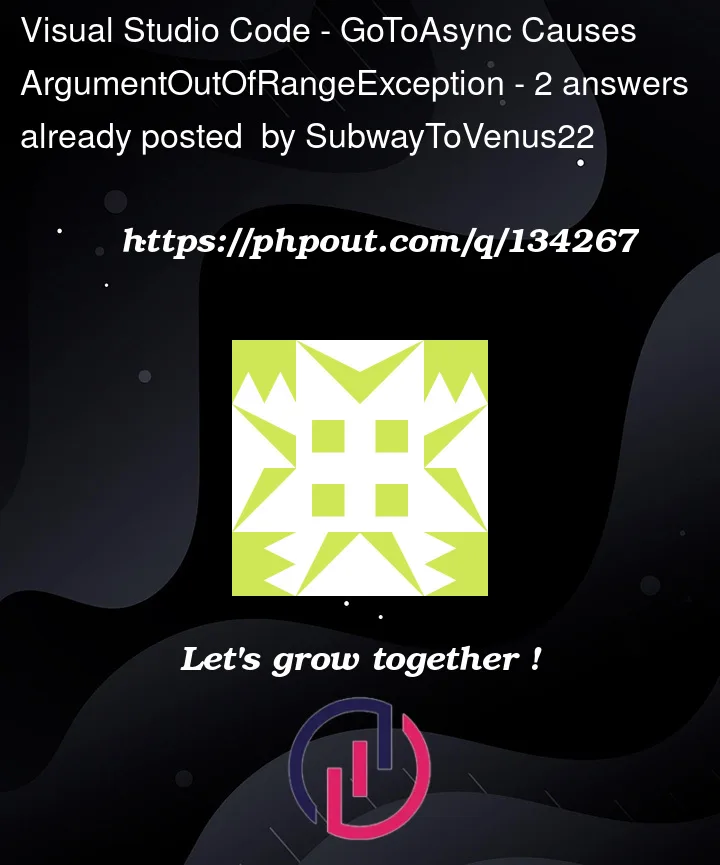Im creating a .NET MAUI app and following along with a guide on youtube (https://www.youtube.com/watch?v=ddmZ6k1GIkM&t=406s) but altering what the app shows, but the functionality is mostly the same.
When I add navigation to a page and execute that code to go to the new page, I get ArgumentOutOfRangeException and the break mode screen comes up in Visual Studio 2022.
Im using the MVVM community toolkit version 8.1 (latest).
Im not passing any values from page A to new page B (I will once I sort this error out).
My ViewModel for page A contains a [RelayCommand] bound to a button on my UI (this is working fine) but at the end of this [RelayCommand] there is a call to a method which then takes you to the next page (intentionally, as there is no need for user input at this point so I want a different page to come up by itself).
That [RelayCommand] does some calculation then calls GoToInfoPage(), this is not marked [RelayCommand] as it doesnt need to be bound to anything on the UI.
GoToInfoPage() is below
async Task GoToInfoPage()
{
await Shell.Current.GoToAsync(nameof(InfoPage));
}
The XAML on the InfoPage is simple right now:
<?xml version="1.0" encoding="utf-8" ?>
<ContentPage xmlns="http://schemas.microsoft.com/dotnet/2021/maui"
xmlns:x="http://schemas.microsoft.com/winfx/2009/xaml"
xmlns:viewmodel="clr-namespace:People.ViewModels"
x:DataType="viewmodel:InfoPageViewModel"
x:Class="People.Views.InfoPage"
Title="InfoPage">
<VerticalStackLayout>
<Label Text="InfoPage screen" />
</VerticalStackLayout>
</ContentPage>
Its code behind is:
public partial class InfoPage : ContentPage
{
public InfoPage(InfoPageViewModel vm)
{
InitializeComponent();
BindingContext = vm;
}
}
The view and VM are registered in MauiProgram.cs
builder.Services.AddTransient<InfoPage>();
builder.Services.AddTransient<InfoPageViewModel>();
The route is registered in AppShell.xaml.cs:
public partial class AppShell : Shell
{
public AppShell()
{
InitializeComponent();
Routing.RegisterRoute(nameof(InfoPage), typeof(InfoPage));
}
}
The ViewModel for InfoPage is:
public partial class InfoPageViewModel : ObservableObject
{
public InfoPageViewModel()
{
}
}
My AppShell.xaml is below, the page im navigating to is not going to part of the main nav of the app and will only be displayed at certain times:
<?xml version="1.0" encoding="UTF-8" ?>
<Shell
x:Class="People.AppShell"
xmlns="http://schemas.microsoft.com/dotnet/2021/maui"
xmlns:x="http://schemas.microsoft.com/winfx/2009/xaml"
xmlns:views="clr-namespace:People.Views"
Shell.FlyoutBehavior="Flyout">
<ShellContent Title="Home"
ContentTemplate="{DataTemplate views:MainPage}"
Icon="{OnPlatform Android='icon1.png', iOS='icon1.png', MacCatalyst='icon1.png'}"/>
</Shell>
The error is shown here too (there is no parameter ‘index’ that im using so must be part of the framework as it says)
What am I doing wrong here for this error to come up? Any help really appreciated





2
Answers
Looks like I solved it. Thanks to those who answered/commented to help.
Basically a rookie mistake in the end though. It didnt help that the Break Mode screen came up, but hope it helps someone else in future
My
[RelayCommand]executes a method which does something, then moves the user to a new page.What I didnt realise was after the user is moved to the new page, any remaining code still gets executed on the previous page, I assumed that any processing of further code on the previous page would stop as soon as the user was navigated to the new one. So, all I needed to do was put a
return;after theShell.Current.GoToAsync()and it solved the issueI think you are using the Visible property inside the ShellPage? I’m right? Please add shell page here
I think you have similar problems Github
[Update answer]
Try change your Shell
Method update too